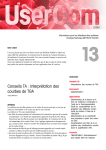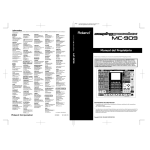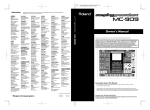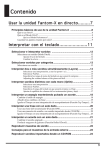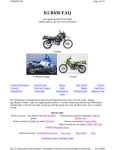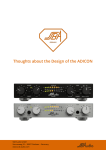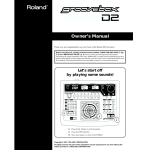Download Roland MC-909 Owner`s manual
Transcript
Thank you, and congratulations on your choice of the Roland MC-909 Sampling Groovebox. The MC-909 comes with two manuals: “Quick Start” and “Owner’s Manual.” This “Quick Start” manual will help you to quickly learn basic operation of the MC-909. Quick Start Completing an original song with the MC-909 Creating an original song (pattern).......................... 2 Select a sound ................................................................................................ 4 Selecting an internal sound.............................................................. 4 Using a sound you sampled ............................................................ 6 Loading data from your computer ............................................... 14 Editing the sound ............................................................................ 14 Recording into the sequencer.................................................................... 14 Creating a performance for the drum part .................................. 14 Creating a performance for the bass part..................................... 19 Recording an arpeggio performance ............................................ 22 Making a one-measure pattern into a four-measure pattern.... 24 Synchronizing the playback of the sampled phrase................... 26 Copying a part from an existing pattern...................................... 26 Editing a pattern ......................................................................................... 26 Adjusting the balance of each part........................................................... 27 Applying effects .......................................................................................... 27 Saving a pattern you create.................................... 28 Mastering.................................................................. 30 Before using this unit, carefully read the sections entitled: “IMPORTANT SAFETY INSTRUCTIONS” (Owner’s Manual p. 2), “USING THE UNIT SAFELY” (Owner’s Manual pp. 3–4), and “IMPORTANT NOTES” (Owner’s Manual p. 5). These sections provide important information concerning the proper operation of the unit. Additionally, in order to feel assured that you have gained a good grasp of every feature provided by your new unit, Quick Start and Owner’s Manual should be read in its entirety. The manual should be saved and kept on hand as a convenient reference. Recording to MD......................................................................................... 31 Producing a CD on your computer.......................................................... 31 Profiles of the pattern creators .............................. 32 ■ Convention Used in This Manual • Words enclosed in square brackets indicate buttons or a dial or a knob or a slider on the panel. • (p. **) indicates a reference page. 985 * The explanations in this manual include illustrations that depict what should typically be shown by the display. Note, however, that your unit may incorporate a newer, enhanced version of the system (e.g., includes newer sounds), so what you actually see in the display may not always match what appears in the manual. 202 Copyright © 2002 ROLAND CORPORATION All rights reserved. No part of this publication may be reproduced in any form without the written permission of ROLAND CORPORATION. Creating an original song (pattern) This section is a step-by-step explanation of how to use the MC-909 to create an original pattern. Select a pattern Let's create an original pattern in user pattern 001. fig.01 23 5 1 4 1. Press [PATTERN] to enter Pattern mode. 2. Press [F1 (List)]. fig.Q1-02 2 When you turn on the power, the MC-909 will always start up in Pattern mode. Creating an original song (pattern) 3. Press [F2 (User)]. 4. Turn [VALUE] to select pattern “U:001.” fig.Q1-02 5. Press [F6 (Select Pattern)]. User pattern 001 is now selected. fig.Q1-03 3 Creating an original song (pattern) Select a sound ■ Selecting an internal sound Here’s how to select a preset patch / rhythm set as the patch / rhythm set used by each part. Selecting a rhythm set (drums) for part 10 fig.02 3 4 6 1 5 2 1. Press [PATCH/SAMPLE] to enter Patch mode. 2. Press part button [10] so it’s lit. If [PART] (SELECT/MUTE) is lit, press the button so it goes out, and then press part button [10] so it’s lit. 4 3. Press [F1 (List)]. 4. Press [F4 (Rhythm)] to display the Rhythm Set List. A rhythm set is already selected for part 10. Creating an original song (pattern) 5. Turn [VALUE] to select a rhythm set. For this example, let’s select “PR-A: 001 909 TR-909 1.” fig.Q1-05 6. You can switch banks by pressing [F1], [F2], or [CURSOR (left/right)]. Press [F6 (Select)]. “PR-A: 001 909 TR-909 1” is now selected for part 10. → "Creating a performance for the drum part" (p. 14) Selecting a bass sound for part 2 Next, we’ll select a bass sound. 1. Press part button [2] so it’s lit. 2. Press [F1 (List)]. 3. Press [F3 (Patch)] to display the patch list. 4. Turn [VALUE] to select a patch. In this example, let’s select “PR-C: 030 SH-101 Bs 2.” A bass sound is already selected for part 2. fig.Q1-04 If you press [F5 (Categ)] to display a “✔” mark in the on-screen check box, you will be able to select patches by category. 5. Press [F6 (Select)]. “PR-C: 030 SH-101 Bs 2” is now selected for part 2. → "Creating a performance for the bass part" (p. 19) In the same way, select sounds for other parts as well. 5 Creating an original song (pattern) ■ Using a sound you sampled Here’s how you can sample a sound (waveform) from a CD or other external audio source, and use that sample to create a patch / rhythm set. In this example we will use a CD player connected to the INPUT L/R jacks, and sample a phrase from the included sample data CD. Connect your CD player to the MC-909 before you continue. Selecting a phrase sampled from CD for part 16 To prevent malfunction and/or damage to speakers or other devices, always turn down the volume, and turn off the power on all devices before making any connections. Let’s sample an approximately four-second phrase from the beginning of track 24 on the included “SAMPLE SHOW” sample data CD. Sampling from CD 1. Press part button [16] so it’s lit. 2. Press [SAMPLING/RESAMPLING] to display the Sampling Menu screen. fig.Q1-06 3. Press [F1 (Sampling)] to display the Sampling Standby screen. 4. Use [CURSOR (up)] to move the cursor to “Input Select.” 5. Turn [VALUE] to select “LINE L/R.” fig.Q1-07 When you set Input Select to “MICROPHONE,” the volume of the connected device will become extremely loud. Before you change the Input Select setting, make sure that the connected device is not producing sound. 6. 6 Press [CURSOR (down)] to move the cursor to “Pre Sample Time.” Creating an original song (pattern) 7. Turn [VALUE] to set the value to “0 ms.” 8. On your CD player, play back track 24 and adjust the input level. While you watch the on-screen level meter, use the [INPUT] knob in the VOLUME section to adjust the volume appropriately. 9. Stop the CD playback, and then press [F2 (Auto Trig)] to display a “✔” mark in the on-screen check box. With this setting, sampling will begin automatically when audio is input. Set the Auto Trigger Level to “5.” 10. Press [F3 (Trim Sw)] to display a “✔” mark in the on-screen check box. After sampling, the start point and end point (Owner’s Manual; p. 115) will automatically be set to the region that contains sound. fig.Q1-08 11. Play back the CD to begin sampling. 12. When you hear the click, press [F5 (Stop)] to stop sampling. The Sample Edit screen will appear. fig.Q1-09 Next, we will edit the sample. On the included sample data CD, a click is recorded at the end point of each phrase. By pressing the velocity pads located at the front edge of the panel, you can audition the sample you are editing. 7 Creating an original song (pattern) Specify the original key and BPM of the sample 1. Press [F2 (Sample Param)]. fig.Q1-10 The jacket of the included sample data CD lists the BPM of each track. Track 24 2. Press [CURSOR (down)] to move the cursor to “Original Key.” 3. Use [VALUE] or [INC/DEC] to set the value to “60 (C4).” With this setting, the sample will play at its original pitch when you press velocity pad [2] (C4). 4. Press [CURSOR (down)] to move the cursor to “BPM.” 5. Use [VALUE] or [INC/DEC] to set the value to “ = 125.00.” 6. Press [F6 (Close)]. Edit the sample has a BPM of = 125. If you do not know the BPM of the sample, you can determine the BPM by pressing the TAP button (Owner's Manual; p. 25) three times or more in time with the sample. The phrase you sampled can be edited in a variety of ways. In this example, we will remove the click noise at the end of the phrase and maximize the volume to prepare the sample for use in a patch. 1. Press [CURSOR (down)] to move the cursor to “End Point.” 2. Turn [VALUE] toward the left to move the end point (the letter “E” displayed above the waveform). While viewing the sample waveform in the screen, move the end point until you can no longer hear the click at the end of the phrase. fig.Q1-11 You can press [INC/DEC] to make fine adjustments to the point. You can expand/shrink the screen display by pressing [CURSOR (left/right)]. 8 Creating an original song (pattern) 3. Press [F4 (Truncate)]. 4. Press [F6 (Execute)]. A message will ask you whether it is OK to delete the unwanted portions of the waveform. 5. Press [F6 (Execute)] once again. The unwanted portions of the sample will be deleted. → Truncate (Owner’s Manual; p. 117) Next, we will maximize the volume. 6. Press [NORMALIZE/AMP]. fig.Q1-12 7. Press [F6 (Execute)]. A message will ask whether it is OK to maximize the volume. 8. Press [F6 (Execute)] once again. The level of the entire sample will be boosted as much as possible without exceeding the maximum volume. → Normalize (Owner’s Manual; p. 121) We are now finished editing the sample. Samples you create will be lost when you turn off the power. In order to keep the sample, you must save it as follows. 9 Creating an original song (pattern) Saving a sample 1. In the Sample Edit screen, press [WRITE]. The Write Menu screen will appear. Make sure that “Sample” is highlighted. fig.Q1-13 2. Press [F6 (Sample)] or [ENTER]. The sample name entry screen will appear. fig.Q1-14 3. Assign a name to the sample you created. For this example, we will save the sample with a name of “Gtr & Pf.” [CURSOR (left/right)] [CURSOR up/down] [VALUE] [INC/DEC] [F1 (Change Type)] [F2 (Delete)] [F3 (Insert)] * 10 Moves the cursor (the location at which to enter/edit a character). Switches letters between uppercase and lowercase. Selects characters. Selects the type of character. Each time you press this, you will alternately select the first character of the uppercase alphabet (A), lowercase alphabet (a), or numerals and symbols (0). Deletes the character at the cursor location, while shifting the following characters to the left, closing the gap. Inserts a space at the cursor location. If you decide to cancel while entering the name, press [F5 (Cancel)]. Creating an original song (pattern) 4. When you have finished entering the name, press [F6 (Write)]. A screen in which you can select the write destination will appear. fig.Q1-15 5. Use [CURSOR (left/right)] to select whether you will save the sample in the user area or on a memory card. For this example, select the user area (User). 6. Use [VALUE] or [INC/DEC] to select the write-destination user sample. For this example, select “U0001.” 7. Press [F6 (Write)]. A message will ask whether you are sure you want to save the sample. If the write-destination sample already contains data, that data will be erased. fig.Q1-16 8. * If you want to save the sample, press [F6 (Execute)]. To cancel, press [F5 (Cancel)]. Next we will create a patch from the sample that we just saved. 11 Creating an original song (pattern) Creating a patch from a sample 1. Press [F5 (Create Patch)]. A screen in which you can enter a name for the patch will appear. For this example, we will save the patch with a name of “Gtr & Pf.” For details on entering a name, refer to p. 10. fig.Q1-17 2. When you have finished entering the name, press [F6 (Write)]. A screen in which you can specify the write-destination for the patch will appear. fig.Q1-18 3. Use [CURSOR (left/right)] to select whether you will save the patch in the user area or on a memory card. For this example, select the user area (User). 4. Use [VALUE] or [INC/DEC] to select the write-destination user patch. For example, select “USER:001.” 12 The user patch data that previously occupied that write destination will be erased. Creating an original song (pattern) 5. Press [F6 (Write)]. A message will ask you to confirm that it is OK to write the data. fig.Q1-19 6. Press [F6 (Execute)]. Now the sample can be used as user patch “U:001.” The screen will ask you whether you want the newly created user patch 001 to be assigned to the currently selected part (part 16). 7. Press [F6 (Execute)]. User patch 001 is now selected for part 16. The Patch Edit (Owner’s Manual; p. 54) screen will appear. 8. Press [EXIT]. You will return to the top screen of Patch mode. → "Synchronizing the playback of the sampled phrase" (p. 26) Selecting a rhythm set created by chopping a sample for part 10 You can use the Auto Chop operation to divide a sampled rhythm pattern into multiple samples at divisions of the beat, and use these samples as the instruments (rhythm tones) of a rhythm set. → Auto Chop (Owner’s Manual; p. 118) → Create Rhythm (Owner’s Manual; p. 119) 13 Creating an original song (pattern) ■ Loading data from your computer WAV or AIFF format wave files from your computer can be loaded into the MC-909 as samples, and used in a patch or rhythm set. → (Owner’s Manual p. 132) ■ Editing the sound You can edit various aspects of the sound, such as its brightness, thickness, volume envelope, and pan. • Editing the sound of a patch → Patch Edit (Owner’s Manual; p. 54) • Editing the sound of a rhythm set → Rhythm Edit (Owner’s Manual; p. 70) Recording into the sequencer ■ Creating a performance for the drum part Here’s how you can create a simple phrase for the rhythm part. In this example we will use the TR-REC recording method. TR-REC is a method of recording in which you can create a phrase simply by pressing buttons. 1. Press [REC]. fig.Q2-01 14 Verify that part button [10] is lit. If it is unlit, press part button [10] so it lights. Creating an original song (pattern) 2. Press [F2 (TR-Rec)]. The TR-REC standby screen will appear. Here you can specify the time signature and length of the pattern. fig.Q2-02 3. Press [CURSOR (down)] to move the cursor to “Rec Measure Length.” 4. Use [VALUE] or [INC/DEC] to select “1.” Leave the settings at their default values, with a Rec Beat (pattern time signature) of “4/4” and Rec Velocity of “REAL.” 5. Press [F6 (BPM/Click)]. The BPM window will appear. 6. Turn [VALUE] to set BPM to = 140.0. 7. Press [F6 (Close)] to close the BPM window. 8. Press [PLAY] to begin recording. Rec Velocity specifies the volume of the notes that you will input. With the “REAL” setting, you can vary the dynamics of the notes by the force with which you strike the pads. Now you can record part 10. fig.Q2-02a 15 Creating an original song (pattern) Inputting the kick drum 1. Press [F3 (Note Number)]. Now you can select the note number of the rhythm tone you want to input. 2. Use [VALUE] or [INC/DEC] to select “60 (C4).” Now you can input the kick drum. fig.Q2-03 3. Press the velocity pads so that the pads marked by the arrows in the diagram are lit. fig.TRrec1 The screen display will be as follows. You should hear the kick drum that you input. fig.Q2-04 Next, we will input the hi-hat. The procedure is the same as in steps 1–3. 16 You can also use [CURSOR (up/down)] to select the note number. You can add dynamics to the sound by varying the force with which you press the velocity pad. Creating an original song (pattern) Inputting the hi-hat 4. Press [F3 (Note Number)], and use [VALUE] or [INC/DEC] to select “70 (A#4)” (the note number for the closed hi-hat). fig.Q2-05 5. Press the velocity pads so that the pads marked by the arrows in the diagram are lit. fig.TRrec2 fig.Q2-06 17 Creating an original song (pattern) 6. As you did in step 4, select “72 (C5)” (the note number for the open hi-hat). 7. Press the velocity pads so that the pads marked by the arrows in the diagram are lit. fig.TRrec3 fig.Q2-07 8. Press [STOP] to stop recording. This completes a one-measure rhythm pattern. Record the drum part in this way. 18 Creating an original song (pattern) ■ Creating a performance for the bass part Next, we will create a phrase for the bass part. Here we will use a recording method called “step recording,” in which you will input notes one by one. Let’s input the bass phrase shown below. Verify that part button [2] is lit. If it is unlit, press part button [2] so it lights. fig.StepRec0 We will shift the range of the velocity pads down to the bass range. 1. Press [OCT -] three times. Pad [2] will now be “C1” and pad [11] will be “A1.” 2. Press [REC]. 3. Press [F3 (Step)]. The step recording standby screen will appear. fig.Q2-08 4. Although the first note is written here as “A2” on the musical staff, electric bass and contrabass actually sound one octave lower than written, so you will input “A1.” Press [PLAY] to begin recording. Now you will be able to record part 2. fig.Q2-09 19 Creating an original song (pattern) 5. Press [F4 (Note Type)]. 6. Turn [VALUE] to select “1/8 ().” fig.Q2-10 7. Press velocity pad [11]. An eighth note will be input at A1. fig.StepRec1 The screen will show the following. fig.Q2-11 8. Press [CURSOR (right)] twice. The note input position will advance by two eighth notes. This is the same as if you had input two eighth-note rests (one quarter-note rest). fig.StepRec2 20 Creating an original song (pattern) 9. Next, successively press velocity pad [11], [CURSOR (right)], and velocity pad [11] to input two more notes. fig.StepRec3.e [11] [11] [CURSOR (right)] 10. Turn [VALUE] to select “1/16 ()” as the Note Type. 11. Press [CURSOR (right)]. The note input position will advance by one sixteenth note. This means that you have input a sixteenth-note rest. fig.StepRec4 12. Press velocity pad [6]. A sixteenth note will be input at E1. 13. Press [F3 (Tie)]. The length of the sixteenth note you input in step 12 will be extended by a sixteenth note. This is the same as if you had input an eighth note. fig.StepRec5 If you need to input just one longer note among short notes, using a tie is faster than changing the Note Type. fig.Q2-12 14. Press [STOP] to stop recording. This completes a one-measure bass pattern. After you have finished recording the bass pattern, you should press [OCT -] and [OCT +] simultaneously to set Octave Shift back to 0. 21 Creating an original song (pattern) ■ Recording an arpeggio performance Let’s use the arpeggiator and chord memory to realtime-record arpeggios on part 3. Realtime recording is the method in which your performance is recorded exactly as you play it. Selecting a sound to use for part 3 In this example let’s select “PR-A: 003 JP OctAttack.” The selection procedure is the same as in "Selecting a rhythm set (drums) for part 10" (p. 4). Selecting how the arpeggio will be sounded To specify how the arpeggio will be sounded, we will select the arpeggio style and the chord form that will determine the structure of the chord. In this example, we will select the arpeggio style “Preset071” and the chord form “P038: G Maj add9.” 1. Hold down [ARPEGGIO] and turn [VALUE] to select “Preset071.” 2. Hold down [ARPEGGIO] and press [F6 (Arp Setting)]. The arpeggiator settings screen will appear. Make the settings shown below. fig.Q2-13 3. Press [F5 (Close)]. 4. Hold down [CHORD MEMORY] and turn [VALUE] to select “P038: G Maj add9.” These settings will specify how the arpeggio will be sounded. When you press the velocity pads, an arpeggio will sound. • Arpeggiator → Owner’s Manual; p. 30 • Chord Memory → Owner’s Manual; p. 32 22 Verify that part button [3] is lit. If it is unlit, press part button [3] so it lights. Creating an original song (pattern) Recording 1. Press [PATTERN] to enter Pattern mode. 2. Press [REC]. 3. Press [F1 (Realtime)]. The realtime recording standby screen will appear. For details on the settings, refer to p. 37 in the Owner’s Manual. fig.Q2-14 4. Press [PLAY] to begin recording. The pattern will play back repeatedly. 5. Press velocity pad [4] at the beginning of the pattern, and continue holding it down until the pattern ends. The arpeggio will play while you continue holding down the velocity pad, and will be recorded. 6. Press [STOP] to stop recording. When you have finished recording, press [ARPEGGIO] and [CHORD MEMORY] so the indicators are extinguished. About the key for Chord Memory When you press velocity pad [2], Chord Memory will sound a chord at the registered key (for preset 038, this will be “G Maj add9”). Here we will press pad [4] to play an “A Maj add9” chord (arpeggio) to match the key of the bass part. Next, we will create a four-measure pattern based on this one-measure pattern. 23 Creating an original song (pattern) ■ Making a one-measure pattern into a four-measure pattern Let’s create a four-measure pattern by copying the one-measure pattern you just recorded. Make sure that pattern “U:001” is selected in Pattern mode. 1. Press [F2 (Edit)]. The Pattern Edit Menu screen will appear. fig.Q2-15 2. Make sure that both “Source From” and “Source End” are set to “001.” If they are set to anything other than “001”, press [CURSOR (left/right)] to move the cursor, and turn [VALUE] to select “001.” 3. Hold down [SHIFT] and press [PART ASSIGN]. All of the part buttons will go dark. 4. Press part buttons [2], [3], and [10] to make them light. The copy will be executed only for part 2, part 3, and part 10. 5. Press [F2 (Copy)]. The Copy sub-window will appear. Here you can specify the destination for the copy. 24 Creating an original song (pattern) 6. Press [CURSOR (down)] several times to move the cursor to “Dest Meas.” 7. Turn [VALUE] to select “002.” 8. Press [CURSOR (down)] several times to move the cursor to “Copy Times.” 9. Turn [VALUE] to select “3.” The pattern will be copied three times. fig.Q2-16 10. Press [F6 (Execute)] to carry out the copy. The performance of the first measure will be copied to measures 2–4. fig.Q2-17 11. Press [EXIT] to finish editing. The four-measure pattern is now completed. 25 Creating an original song (pattern) ■ Synchronizing the playback of the sampled phrase Here’s how the phrase you sampled in "Selecting a phrase sampled from CD for part 16" (p. 6) can be synchronized to the sequencer pattern. 1. Press part button [16] so it’s lit. 2. Press [AUTO SYNC] so its indicator is lit. The sample used by the patch of part 16 will synchronize to the tempo of the pattern. 3. Press [REC]. 4. Press [F1 (Realtime)]. The realtime-recording standby screen will appear. For details on the settings, refer to p. 37 in the Owner’s Manual. 5. Press [PLAY] to begin recording. The pattern will play repeatedly. 6. Press [OCT -] so its indicator is lit. The range of the velocity pads is shifted one octave lower. 7. At the beginning of the pattern and at the beginning of the third measure, press velocity pad [10] and hold it for two measures each time. While you hold down the velocity pad, the phrase will play back and will be recorded. 8. Press [STOP] to stop recording. If you change the tempo of the pattern, the tempo of the sample will change correspondingly. ■ Copying a part from an existing pattern A part from a preset pattern or a different user pattern can also be copied and used. For the procedure, refer to p. 44 in the Owner’s Manual. Editing a pattern You can edit a pattern in various ways. For example, you can correct the timing of the performance in a pattern you’ve recorded, or change the number of measures. • To edit in units of a measure → Pattern Edit (Owner’s Manual; p. 43) • To edit individual events of performance data → Microscope (Owner’s Manual; p. 47) 26 You press pad [10] in order to match the key of the bass. Creating an original song (pattern) Adjusting the balance of each part Use the part mixer (the eight sliders in the center of the panel) to adjust the volume balance and pan of each part. 1. Press [F3 (Mixer)] or [MIXER ASSIGN]. The Mixer screen will appear. fig.Mixer 2. Press [PART ASSIGN] to select the parts that you want to adjust. When the [PART ASSIGN] indicator is dark, you can adjust parts 1–8. When the indicator is lit, you can adjust parts 9–16. 3. Adjust the volume, pan, etc., of each part. • • • • * 4. Press [F1 (Level)] and adjust the volume. Press [F2 (Pan)] and adjust the left/right pan position. Press [F3 (Key Shift)] and adjust the transposition. Press [F4 (Reverb Level)] and adjust the depth of the reverb. Alternatively, you can use [CURSOR] to select the part and parameter, or use [VALUE] or [INC/DEC] to adjust the value. Press [F6 (Close)], [MIXER ASSIGN] or [EXIT] to return to the previous screen. Applying effects As necessary, you can apply effects such as compressor, reverb, or multi-effects. Refer to p. 88 in the Owner’s Manual. 27 Saving a pattern you create Pattern data you create will be lost if you re-select the pattern or turn off the power. Here’s how to save your data if you want to keep it. 1. Press [PATTERN] to enter Pattern mode. 2. Press [WRITE]. The Write Menu screen will appear. Make sure that “Pattern” is highlighted. fig.Q3-01 3. Press [F1 (PTN)] or [ENTER]. The pattern name entry screen will appear. fig.Q3-02 4. Assign a name to the pattern you created. [CURSOR (left/right)] [CURSOR up/down] [VALUE] [INC/DEC] [F1 (Change Type)] [F2 (Delete)] [F3 (Insert)] * 28 Moves the cursor (the location at which to enter/edit a character). Switches letters between uppercase and lowercase. Selects characters. Selects the type of character. Each time you press this, you will alternately select the first character of the uppercase alphabet (A), lowercase alphabet (a), or numerals and symbols (0). Deletes the character at the cursor location, while shifting the following characters to the left, closing the gap. Inserts a space at the cursor location. If you decide to cancel while entering the name, press [F5 (Cancel)]. Saving a pattern you create 5. When you are finished entering the name, press [F6 (Write)]. A screen in which you can select the write-destination pattern will appear. fig.Q3-03 6. Use [CURSOR (left/right)] to select whether you will save the pattern in the user area or on a memory card. For this example, select user area (User). 7. Use [VALUE] or [INC/DEC] to select the write-destination user pattern. 8. Press [F6 (Write)]. A message will ask whether you are sure you want to write the data. fig.Q3-04 9. * If the write-destination pattern contains data, that data will be erased. To write the data, press [F6 (Execute)]. To cancel, press [F5 (Cancel)]. 29 Mastering The MC-909 provides a compressor (mastering effect) that splits the sound into high, mid, and low-frequency bands and makes the volume of each band more consistent. When mixing down to MD or DAT, or when using a CD-R disc to produce your own original audio CD, this lets you master at an optimized level. Switching the mastering effect on/off 1. In the MASTERING section, press [ON]. Each time you press this button, the mastering effect will be switched on (indicator lit), or off (indicator extinguished). Selecting a preset setting The mastering effect provides three settings suitable for different styles. 1. Press [F5 (Mastering)]. The mastering effect setting screen will appear. fig.Q4-01 2. One by one, press [F1 (Techno)] through [F3 (Break Beats)]. Settings appropriate for the selected style will be applied. Listen to the differences between these settings. • Mastering effect → Owner’s Manual; p. 108 Mastering can be done either by recording on a device that is connected to the MC909, or by converting the data to a WAV/AIFF file and sending it via USB to your computer, where the file can be burned to CD-R. You can vary the playback of the pattern you create by switching muting on/off or using realtime modify to vary the playback during mastering, or you can create a song for mastering. 30 Mastering Recording to MD Analog recording Connect your MD recorder to the MIX OUTPUT jack, and perform the mixdown. Digital recording Connect your MD recorder to the digital out connector, and perform the mixdown. Producing a CD on your computer The original song you created can be resampled into a stereo sound file (WAV/ AIFF). This file can then be transferred to your computer via USB or by using a card reader, and burned onto a CD-R disc to produce an audio CD. • Resampling → Owner’s Manual; p. 112 • File utility → Owner’s Manual; p. 134 • USB → Owner’s Manual; p. 135 31 Profiles of the pattern creators Nick Tidy Nick is a free-lance electronic music composer. More specifically, he's a dance music composer / producer / remixer commissioned by clients to compose electronic music in the desired style and genre. Hans-Joerg Scheffler Born and raised in the Ruhrvalley, one of the largest industrial areas of europe, Hans interest in noise and rhythm came quite naturally. Today he runs his own company Digital Audio Design and creates patches and patterns for Roland Synthesizers and Grooveboxes. http://www.digitalaudiodesign.net/ Heigo Tani (wall5/Co-Fusion) Active with the leading Japanese techno DJ “DJ WADA” as the techno unit “Co-Fusion.” Has released albums from Sublime Records. Q'HEY Heads the “MOON AGE RECORDINGS” label, and “REBOOT” parties at Aoyama Maniac Love. Started DJ activities in 1989, and continues to this day as a leader on the Tokyo techno scene. Active on the cutting edge in Japan as well as in Asia and Europe. Indispensable as a DJ for big parties and festivals, he continues to win the support of numerous fans. Also created the internal presets and patterns of the MC-505. Active as an equipment reviewer and writer for music and instrument publications. NEURON (Kouichi Ohkama) Started his activities in ‘92 as a unit named “Electric Bodybeat/ Industrial,” and debuted in ‘97 with “Public House Record” from the UK label NU-NRG. Active as a NU-NRG/Hard Trance artist in Japan and abroad, producing tracks and performing live. Currently pursuing unique sounds with a more heavily psychedelic flavor. Masa Japanese psychedelic trance originator with numerous releases from trance labels around the world since the early ‘90s. Has collaborated extensively with Japanese and foreign trance artists, such as Mike Maguire and Xavier Morel, and has an enormous influence particularly on the Japanese underground scene. Since ‘98, has been broadening his activities as a member of the psychedelic trance band Kinocosmo, and in ‘02 started the HYPNODISK label. His current and future activities continue to be a focus of attention. B.U.S/aka/BeatPerLove Influenced by NY GARAGE, UK Balearic of about ‘92, and early trance. Produced DJ YO*C’s solo album, and has produced numerous remixes and originals for top Japanese DJs such as DJ Shinkawa and DJ19. Another strength is garage-style vocal songs which he provides to artists. Most recently, formed a unit named BeatPerLove, and devotedly continues his underground activities. Shinichiro Murayama A leading creator/producer on the Japanese music scene. Skilled at dance music, particularly groove-heavy R&B. Has produced numerous hit songs in collaboration with many Japanese top artists. Handles not only composition, arranging, and programming, but engineering as well. Kazuhiko Maeda Composer/Arranger/Producer Active in CD production and as a song producer since the early ‘90s, with numerous releases and a solo album. Operates a music production company named Kent in his own studio, and has produced demo songs and patterns for Roland sound modules and groove boxes. Possesses a wide-ranging musicality, and is admired for the distinctive sonic world he systematically constructs from harmonies and grooves. Cappadocia Productions Electronic sound aficionado residing in Japan. Also active as an art performance unit named GIGAHERTZ. Has been involved in product development for other models in Roland’s series of groove gear. Naoki Matsuura Took up the bass while in middle school. Entered Berklee College of Music. While studying there, he participated in “Tiger’s Baku,” led by Tiger Okoshi. Has also played with numerous musicians such as Tommy Campbell, Paquito de Rivera, and Toninho Horta (and with Japanese musicians such as Masahiko Oosaka, Masaaki Imaizumi, Carlos Kanno, and Yoshihiko Yoshitori). After returning to Japan, he was employed by a musical instrument manufacturer, but later left to establish his own music production company, Presto (Ltd.). Composes and produces various types of music for commercial purposes. Currently pursuing a dual path as a creator and bassist. Kunihiro Ueno • GROOVE COMPETITION JAPAN 2000 grand prix • GROOVE COMPETITION JAPAN 2001 grand prix runner-up Composer who loves electronic music, ethnic music, and traditional Japanese music. Also active in live and DJ performance in the Tokyo area. Devoted himself to techno in the early ‘90s, pursued drum’n’bass in the mid-’90s, and currently continues his musical activities, seeking points of contact between world music and ancient Japanese music. Has a diverse work portfolio that ranges from radio jingles and games to anime sound tracks. grogman (Junichi Oguro) • GROOVE COMPETITION JAPAN 2000 grand prix runner-up • GROOVE COMPETITION JAPAN 2001 grand prix • Techno artist/Remixer/Producer Heads the Sapporo-based techno label “aerostitch,” which has a Total Techno concept. Active in a wide and open-ended range of music, including club tracks and production, as well as live performances both in Japan and abroad. http://www.aerostitch.net Daishiro Minami • GROOVE COMPETITION JAPAN 2001 finalist With the MC-505 as his main machine, produces tracks mainly in techno/minimal styles. Also presents techno live events utilizing groove gear. Says that he will never forget the chance he had to perform at the groove competition. Wants to pass on the excitement and possibilities of techno and groove gear to children through these activities. http://www.geocities.co.jp/MusicHall/4058/ Takatoshi Nishibu • GROOVE COMPETITION JAPAN 2001 finalist His initial music production efforts consisted of mechanically steprecording into a desktop music system, but then he met the MC505 and experienced the enjoyment of manipulating sounds and phrases intuitively, in real time. Wants to continue producing good-sounding electronic compositions that are not limited by preconceptions of genre. Recently involved with background music for exhibition videos. http://sound.jp/tnsb/ 03126701 ’02-12-A3-21N
































